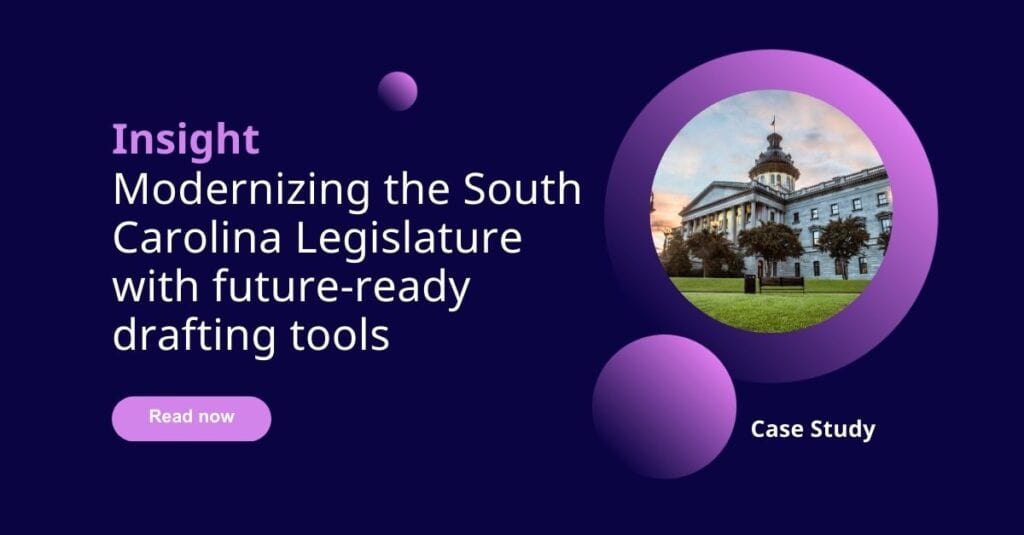When the first digital drafting and statute management tools emerged, they promised to revolutionize legislative work. Yet, as technology advanced, these systems grew increasingly complex, with layers of added functionality creating a complicated system that consumes much of legislative teams’ time. Today, many teams are grappling with outdated, cumbersome tools that slow them down instead of helping them work more efficiently.
Software, originally designed to streamline processes, has instead created overwhelming interfaces, fragmented workflows, and collaboration bottlenecks. As the deliberative process of legislative work demands more and more time, drafting attorneys need modern solutions. Prioritizing user experience (UX) and workflow efficiency without compromising legislative precision is key.
Transitioning from Disjointed Collaboration to Efficient Systems
Collaboration is at the heart of legislative drafting, yet legacy systems create information silos.
Many legislative staff still rely on multiple disconnected systems to draft, review, and approve documents. This mix of workspaces forces users to track amendments and citations manually, leading to inefficiencies and errors. The process of navigating multiple workspaces for a single task has become a daily frustration. Teams rely on email chains and external databases, the navigating of which adds to staff’s cognitive load.
Legislative teams need technology that enhances efficiency, not complexity. A well-designed system should offer automation. This will allow drafting attorneys and legislative staff to focus on their core work without unnecessary friction.
With a smarter, more streamlined approach, legislative teams can move beyond outdated workflows and embrace a system that is adapted to their needs, rather than drafting staff having to adapt their processes to suit the technology.
So how can legislative teams work towards a more efficient, coherent workflow process?
A Smarter Approach: Modern Drafting & Workflow Management
With the resources needed to adopt new systems and facilitate training, it is important to integrate technology that is both familiar and addresses the specific nuances of legislatures. Propylon has worked with 25 percent of all US legislatures, so our solutions are built with real legislative workflows in mind. It is integral solutions address the core challenges faced by drafting teams while maintaining the flexibility required.
Simple UX for Legislative Drafting
A modern drafting solution should enhance, not hinder, the user experience. New technology should support drafting attorneys in their role and enable faster responses to police changes. Focusing on a solution that works within the familiar setting of Microsoft Word will minimize the time spent training professionals on multiple platforms.
Seamless Workflow Integration
A system that integrates drafting, review, and approval into a single, cohesive workflow will free up a lot of a team’s cognitive space. Instead of switching between multiple applications, users can draft, edit, and track legislative documents in one environment, with automated cross-referencing ensuring every citation stays up to date. Version control logs every change, creating an audit trail that ensures accuracy and transparency.
The broad process of drafting, amending, codifying and publishing legislations will always be laborious, but adopting technology with those responsible in mind can ensure their own workflows are organized in a way that they find most accessible. You can read our case study on How Montana moved its codification process away from the mainframe for further insight into how other legislatures have completely modernized the process and now complete annotations in a third of the time.
The Power of Web-Based Legislative Tools
Modern legislative teams are moving away from traditional thick-client applications (which require installation on individual computers) in favor of browser, thin-client solutions. With a cloud-based approach, legislative staff gain:
- Access Anywhere, anytime: Work securely from any authenticated browser, on any device.
- Seamless Updates: No IT maintenance required because updates roll out automatically. In the age of constant new technologies, this will save a lot of unnecessary communications with IT teams.
- Enhanced Security: Hosted on AWS with compliance standards like FedRAMP, ensuring legislative data remains protected enabling peace of mind that being tech forward does not endanger security.
Future-Proofing Legislative Workflows
Legislatures need modern drafting solutions that streamline work, not outdated tools that add complexity. With the emergence of new technologies, such as generative AI, it has never been more important to prioritize adaptable, secure technology.
A modern legislative technology will enable teams to work faster, collaborate seamlessly, and maintain legislative integrity.

